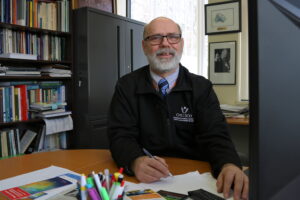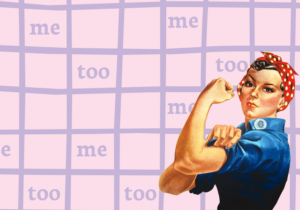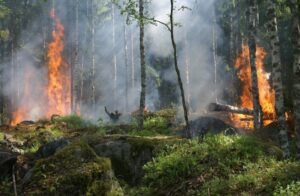
In a world fraught with wars and conflicts, the Democratic Republic of the Congo is one of the most conflicted nations of Africa. Yet, why should we care? To begin, scholars argue that these so called failed states present serious security and stability risks for the rest of the world. With them we face potential spillover threats of disease, refugees and war. Some would argue that this is not enough to get involved and that we should just leave them to their own devices. Today, western countries spend billions of dollars in aid to what are called the ‘bottom billion’, or rather the poorest billion people in the world. This aid while well intentioned is oft times misspent. The concepts of development and security sit across rather large conceptual fields and neither of the two camps discusses their issues on this together. Development and Security go hand in hand and cannot exist without the other. You cannot develop a country without ensuring that development has a chance of sticking, and vice versa. In order to understand how these two issues are connected I will begin by discussing some of the history of this vast and wealthy nation with a focus on some potential solutions.
King Leopold’s Ghost
The DRC is a central African country approximately 2/3 the size of Europe. With a population of around 54 million people it is also one of the most populous. To date, the DRC has been passed on from one owner to another. Beginning with King Leopold II in the late 1800’s until the Congo gained its independence in 1960 with the election of Patrice Lumumba, the Congolese people faced the extermination of 10 million people in less than a century, complete separation and disenfranchisement from their civil society and political life and lived in a patrimonial system in which they were used to further expand the wealth and resources of the Belgian empire.
Following their freedom with Lumumba at the helm, western powers worked quickly to exterminate him due to his perceived communist leanings. After Lumumba was assassinated, Mobutu Sese Seko was put into power in a ruthless dictatorship that lasted until the late 1990’s. Mobutu dubbed himself the King of the Congo and ruthlessly used and exploited the country’s wealth. During this time, whatever infrastructure created and implemented by the Belgians saw its demise. By end of his rule there were roughly 15% percent of the roads the Belgians left still in existence, little to no state capacity, endless war and corruption to name but a very few of the problems the Congolese faced.
Following Mobutu, we enter the time period of Laurent Kabila and we experience the further disintegration of the Congolese state with severe economic exploitation and much of the country left to its own devices. During this time L. Kabila was able to maintain complete control around the area of Kinshasa and used the country to further his personal wealth with little to no regard for the well-being of his Congolese compatriots. In 2001 L. Kabila died and his son Joseph Kabila inherited the country. Towards the end of L. Kabila’s presidency the DRC was a part of the first Congo war which lasted from 1997-1998, it was directly after this that the Second Congo War began and in which 8 other African nations and various other military groups participated. This is one of the most violent and protracted conflicts Africa has seen with at least 5 million deaths and countless refugees by the time of its end. Although peace talks occurred and the conflict “officially” ended various regions of the DRC remain under conflict. Militant groups from Rwanda and Uganda control the areas close to their borders and exploit them for their vast resources.
Solutions
Now that the vast number of problems that this beleaguered Congolese nation faces has been charted can the various types of solutions be discussed. These are but a few; increased investment into infrastructure, implementation of a regionalized governmental structure and re-allocation of foreign aid. Arguably, the true cause of all of these problems can be routed very simplistically into one all-encompassing area, i.e., the lack of state capacity. Due to the turbulent history of the Congo and the lack of a coherent responsible government there is little to no state capacity of any kind. There is no infrastructure, roads and most importantly no legitimacy in government. Thus, the next logical conclusion is that potential solutions must be centered and focused on the core of the issues at hand. Without state capacity, it is nearly impossible for the DRC to emerge from the status of failed state.
Foreign Aid and Infrastructure
Sources state that the World Bank, the DRC’s largest donor currently only invests 15 million of over 1 billion dollars in aid into infrastructure. This does not make sense. If you look at the history of the World Bank and its raison d’etre then you will see that it only came into existence to facilitate the rebuilding of post WWII Europe. Therefore, this lack of funds invested into infrastructure does not correlate with the history of post war re-building that Europe experienced. Today there are only two main paved roads in the entirety of the country; a territory 2/3 the size of Europe needs a vast network of roads to facilitate the economic growth of the country, create national unity and even basic forms of democracy such as transportation of ballots from one area to another to name but a few.
Regionalization
Finally, some argue that due to the vastness of the territory one of the potential solutions to create stability is the implementation of regionalization. In 2006, a new constitution was implemented that allowed for provinces to have their own ministers, governors and assemblies. Unfortunately, this also carried with it a caveat that ultimately required all approval for such in the hands of the President. However what is important to note here is that the alteration in the Constitution of 2006 shows that the Congolese people are open to change. This regionalization would allow for local areas to become more connected to their communities and allow for civil society to potentially flourish. With the control of the area around their homes the Congolese people would be invested in the success of their region, they could shape their structures around main cities and allow for infrastructure to be built from the ground up and not implemented from the top down as it currently is. Obviously, the potential success of such would require buy-in from the central authority but that too would likely require change. In a recent debate on the future of the Congo, one thing that could be taken away is that change is needed and desperately wanted. There is hope for the future of the Congolese people if only they are given the proper tools to make it happen.
 In a world fraught with wars and conflicts, the Democratic Republic of the Congo is one of the most conflicted nations of Africa. Yet, why should we care? To begin, scholars argue that these so called failed states present serious security and stability risks for the rest of the world. With them we face potential spillover threats of disease, refugees and war. Some would argue that this is not enough to get involved and that we should just leave them to their own devices. Today, western countries spend billions of dollars in aid to what are called the ‘bottom billion’, or rather the poorest billion people in the world. This aid while well intentioned is oft times misspent. The concepts of development and security sit across rather large conceptual fields and neither of the two camps discusses their issues on this together. Development and Security go hand in hand and cannot exist without the other. You cannot develop a country without ensuring that development has a chance of sticking, and vice versa. In order to understand how these two issues are connected I will begin by discussing some of the history of this vast and wealthy nation with a focus on some potential solutions.
King Leopold’s Ghost
The DRC is a central African country approximately 2/3 the size of Europe. With a population of around 54 million people it is also one of the most populous. To date, the DRC has been passed on from one owner to another. Beginning with King Leopold II in the late 1800’s until the Congo gained its independence in 1960 with the election of Patrice Lumumba, the Congolese people faced the extermination of 10 million people in less than a century, complete separation and disenfranchisement from their civil society and political life and lived in a patrimonial system in which they were used to further expand the wealth and resources of the Belgian empire.
Following their freedom with Lumumba at the helm, western powers worked quickly to exterminate him due to his perceived communist leanings. After Lumumba was assassinated, Mobutu Sese Seko was put into power in a ruthless dictatorship that lasted until the late 1990’s. Mobutu dubbed himself the King of the Congo and ruthlessly used and exploited the country’s wealth. During this time, whatever infrastructure created and implemented by the Belgians saw its demise. By end of his rule there were roughly 15% percent of the roads the Belgians left still in existence, little to no state capacity, endless war and corruption to name but a very few of the problems the Congolese faced.
Following Mobutu, we enter the time period of Laurent Kabila and we experience the further disintegration of the Congolese state with severe economic exploitation and much of the country left to its own devices. During this time L. Kabila was able to maintain complete control around the area of Kinshasa and used the country to further his personal wealth with little to no regard for the well-being of his Congolese compatriots. In 2001 L. Kabila died and his son Joseph Kabila inherited the country. Towards the end of L. Kabila’s presidency the DRC was a part of the first Congo war which lasted from 1997-1998, it was directly after this that the Second Congo War began and in which 8 other African nations and various other military groups participated. This is one of the most violent and protracted conflicts Africa has seen with at least 5 million deaths and countless refugees by the time of its end. Although peace talks occurred and the conflict “officially” ended various regions of the DRC remain under conflict. Militant groups from Rwanda and Uganda control the areas close to their borders and exploit them for their vast resources.
Solutions
Now that the vast number of problems that this beleaguered Congolese nation faces has been charted can the various types of solutions be discussed. These are but a few; increased investment into infrastructure, implementation of a regionalized governmental structure and re-allocation of foreign aid. Arguably, the true cause of all of these problems can be routed very simplistically into one all-encompassing area, i.e., the lack of state capacity. Due to the turbulent history of the Congo and the lack of a coherent responsible government there is little to no state capacity of any kind. There is no infrastructure, roads and most importantly no legitimacy in government. Thus, the next logical conclusion is that potential solutions must be centered and focused on the core of the issues at hand. Without state capacity, it is nearly impossible for the DRC to emerge from the status of failed state.
Foreign Aid and Infrastructure
Sources state that the World Bank, the DRC’s largest donor currently only invests 15 million of over 1 billion dollars in aid into infrastructure. This does not make sense. If you look at the history of the World Bank and its raison d’etre then you will see that it only came into existence to facilitate the rebuilding of post WWII Europe. Therefore, this lack of funds invested into infrastructure does not correlate with the history of post war re-building that Europe experienced. Today there are only two main paved roads in the entirety of the country; a territory 2/3 the size of Europe needs a vast network of roads to facilitate the economic growth of the country, create national unity and even basic forms of democracy such as transportation of ballots from one area to another to name but a few.
Regionalization
Finally, some argue that due to the vastness of the territory one of the potential solutions to create stability is the implementation of regionalization. In 2006, a new constitution was implemented that allowed for provinces to have their own ministers, governors and assemblies. Unfortunately, this also carried with it a caveat that ultimately required all approval for such in the hands of the President. However what is important to note here is that the alteration in the Constitution of 2006 shows that the Congolese people are open to change. This regionalization would allow for local areas to become more connected to their communities and allow for civil society to potentially flourish. With the control of the area around their homes the Congolese people would be invested in the success of their region, they could shape their structures around main cities and allow for infrastructure to be built from the ground up and not implemented from the top down as it currently is. Obviously, the potential success of such would require buy-in from the central authority but that too would likely require change. In a recent debate on the future of the Congo, one thing that could be taken away is that change is needed and desperately wanted. There is hope for the future of the Congolese people if only they are given the proper tools to make it happen.
In a world fraught with wars and conflicts, the Democratic Republic of the Congo is one of the most conflicted nations of Africa. Yet, why should we care? To begin, scholars argue that these so called failed states present serious security and stability risks for the rest of the world. With them we face potential spillover threats of disease, refugees and war. Some would argue that this is not enough to get involved and that we should just leave them to their own devices. Today, western countries spend billions of dollars in aid to what are called the ‘bottom billion’, or rather the poorest billion people in the world. This aid while well intentioned is oft times misspent. The concepts of development and security sit across rather large conceptual fields and neither of the two camps discusses their issues on this together. Development and Security go hand in hand and cannot exist without the other. You cannot develop a country without ensuring that development has a chance of sticking, and vice versa. In order to understand how these two issues are connected I will begin by discussing some of the history of this vast and wealthy nation with a focus on some potential solutions.
King Leopold’s Ghost
The DRC is a central African country approximately 2/3 the size of Europe. With a population of around 54 million people it is also one of the most populous. To date, the DRC has been passed on from one owner to another. Beginning with King Leopold II in the late 1800’s until the Congo gained its independence in 1960 with the election of Patrice Lumumba, the Congolese people faced the extermination of 10 million people in less than a century, complete separation and disenfranchisement from their civil society and political life and lived in a patrimonial system in which they were used to further expand the wealth and resources of the Belgian empire.
Following their freedom with Lumumba at the helm, western powers worked quickly to exterminate him due to his perceived communist leanings. After Lumumba was assassinated, Mobutu Sese Seko was put into power in a ruthless dictatorship that lasted until the late 1990’s. Mobutu dubbed himself the King of the Congo and ruthlessly used and exploited the country’s wealth. During this time, whatever infrastructure created and implemented by the Belgians saw its demise. By end of his rule there were roughly 15% percent of the roads the Belgians left still in existence, little to no state capacity, endless war and corruption to name but a very few of the problems the Congolese faced.
Following Mobutu, we enter the time period of Laurent Kabila and we experience the further disintegration of the Congolese state with severe economic exploitation and much of the country left to its own devices. During this time L. Kabila was able to maintain complete control around the area of Kinshasa and used the country to further his personal wealth with little to no regard for the well-being of his Congolese compatriots. In 2001 L. Kabila died and his son Joseph Kabila inherited the country. Towards the end of L. Kabila’s presidency the DRC was a part of the first Congo war which lasted from 1997-1998, it was directly after this that the Second Congo War began and in which 8 other African nations and various other military groups participated. This is one of the most violent and protracted conflicts Africa has seen with at least 5 million deaths and countless refugees by the time of its end. Although peace talks occurred and the conflict “officially” ended various regions of the DRC remain under conflict. Militant groups from Rwanda and Uganda control the areas close to their borders and exploit them for their vast resources.
Solutions
Now that the vast number of problems that this beleaguered Congolese nation faces has been charted can the various types of solutions be discussed. These are but a few; increased investment into infrastructure, implementation of a regionalized governmental structure and re-allocation of foreign aid. Arguably, the true cause of all of these problems can be routed very simplistically into one all-encompassing area, i.e., the lack of state capacity. Due to the turbulent history of the Congo and the lack of a coherent responsible government there is little to no state capacity of any kind. There is no infrastructure, roads and most importantly no legitimacy in government. Thus, the next logical conclusion is that potential solutions must be centered and focused on the core of the issues at hand. Without state capacity, it is nearly impossible for the DRC to emerge from the status of failed state.
Foreign Aid and Infrastructure
Sources state that the World Bank, the DRC’s largest donor currently only invests 15 million of over 1 billion dollars in aid into infrastructure. This does not make sense. If you look at the history of the World Bank and its raison d’etre then you will see that it only came into existence to facilitate the rebuilding of post WWII Europe. Therefore, this lack of funds invested into infrastructure does not correlate with the history of post war re-building that Europe experienced. Today there are only two main paved roads in the entirety of the country; a territory 2/3 the size of Europe needs a vast network of roads to facilitate the economic growth of the country, create national unity and even basic forms of democracy such as transportation of ballots from one area to another to name but a few.
Regionalization
Finally, some argue that due to the vastness of the territory one of the potential solutions to create stability is the implementation of regionalization. In 2006, a new constitution was implemented that allowed for provinces to have their own ministers, governors and assemblies. Unfortunately, this also carried with it a caveat that ultimately required all approval for such in the hands of the President. However what is important to note here is that the alteration in the Constitution of 2006 shows that the Congolese people are open to change. This regionalization would allow for local areas to become more connected to their communities and allow for civil society to potentially flourish. With the control of the area around their homes the Congolese people would be invested in the success of their region, they could shape their structures around main cities and allow for infrastructure to be built from the ground up and not implemented from the top down as it currently is. Obviously, the potential success of such would require buy-in from the central authority but that too would likely require change. In a recent debate on the future of the Congo, one thing that could be taken away is that change is needed and desperately wanted. There is hope for the future of the Congolese people if only they are given the proper tools to make it happen. 








